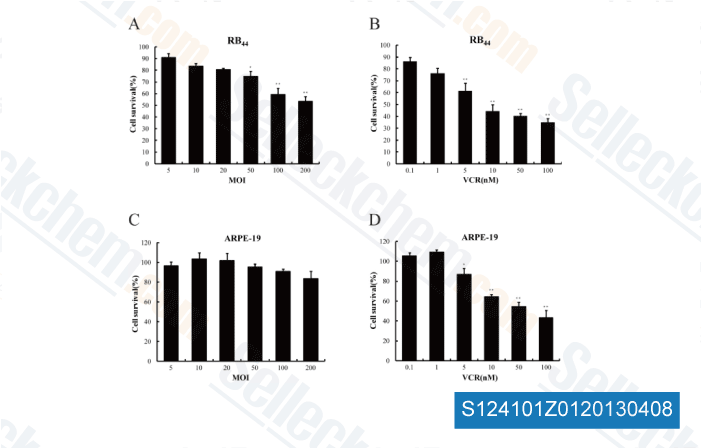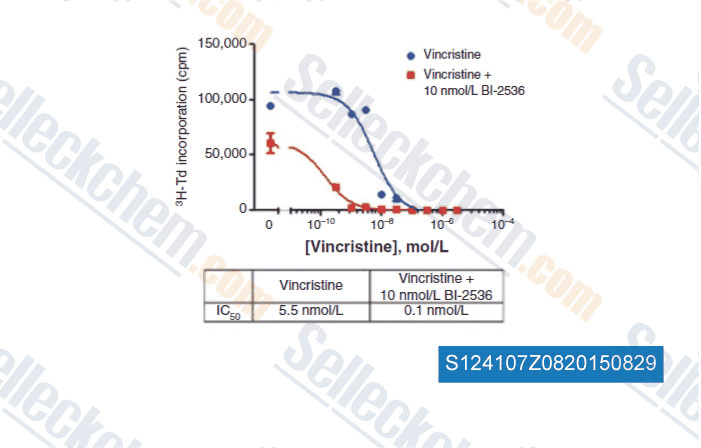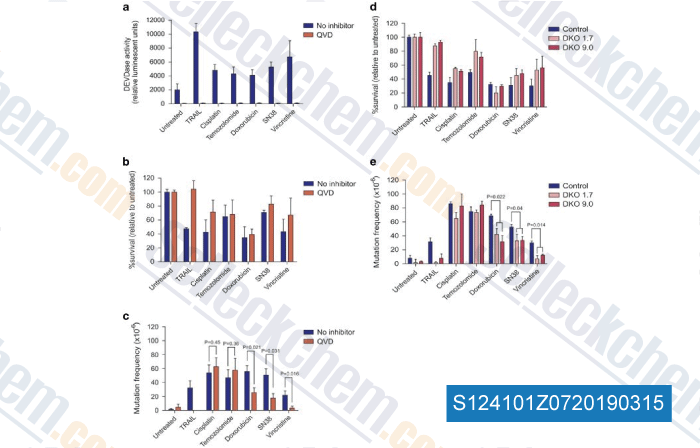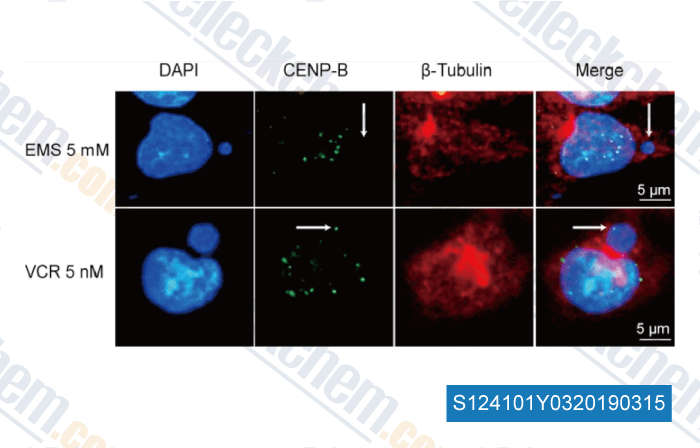|
Toll Free: (877) 796-6397 -- USA and Canada only -- |
Fax: +1-832-582-8590 Orders: +1-832-582-8158 |
Tech Support: +1-832-582-8158 Ext:3 Please provide your Order Number in the email. |
Technical Data
| Formula | C46H58N4O14S |
||||||
| Molecular Weight | 923.04 | CAS No. | 2068-78-2 | ||||
| Solubility (25°C)* | In vitro | DMSO | 100 mg/mL (108.33 mM) | ||||
| Water | 100 mg/mL (108.33 mM) | ||||||
| Ethanol | Insoluble | ||||||
| In vivo (Add solvents to the product individually and in order) |
|
||||||
|
* <1 mg/ml means slightly soluble or insoluble. * Please note that Selleck tests the solubility of all compounds in-house, and the actual solubility may differ slightly from published values. This is normal and is due to slight batch-to-batch variations. * Room temperature shipping (Stability testing shows this product can be shipped without any cooling measures.) |
|||||||
Preparing Stock Solutions
Biological Activity
| Description | Vincristine sulfate is an inhibitor of polymerization of microtubules by binding to tubulin with IC50 of 32 μM in a cell-free assay. Vincristine sulfate induces apoptosis. | ||
|---|---|---|---|
| Targets |
|
||
| In vitro | Vincristine inhibits net addition of tubulin dimers at assembly ends of steady-state microtubules with Ki of 85 nM. [1] At low concentrations, Vincristine stabilizes the spindle apparatus resulting in failure of the chromosomes to segregate leading to metaphase arrest and inhibition of mitosis. At higher concentrations, Vincristine may disrupt and induce total depolymerization of microtubules. [2] Vincristine induces apoptosis in tumor cells and inhibits SH-SY5Y cell proliferation with IC50 of 0.1 μM. Vincristine induces mitotic arrest and promots the expression of caspase-3 and -9 and cyclin B, while decreasing the expression of cyclin D. [4] Vincristine induced neurotoxicity is caused by interference with microtubule function, which results in blockage of axonal transport and thus in axonal degeneration. [5] | ||
| In vivo | Vincristine (3 mg/kg) administrated by a single i.p. injection to mice bearing bilateral subcutaneous xenografts Rh12 or Rh18, induces mean growth delay of >120 and >52 day, and repopulating fractions of 0.06% and 5%, respectively. [6] Vincristine acts on subcutaneous colon 38 tumors in mice by host cell-mediated vascular effects as well as by direct tubulin-mediated cytotoxicity. Vincristine (5 mg/kg) reduces tumor blood flow of tumors by nearly 75% . [7] |
Protocol (from reference)
| Cell Assay:[1] |
|
|---|---|
| Animal Study:[6] |
|
References
|
Customer Product Validation

-
Data from [ Int J Mol Sci , 2012 , 13, 10736-10749 ]

-
Data from [ , , Cancer Research, 2013, 73(20): 6310-22 ]

-
Data from [ , , Cell Death & Disease, 2017, doi:10.1038/cddis.2017.454 ]

-
Data from [ , , Chemosphere, 2018, 210:467-475 ]
Selleck's Vincristine sulfate has been cited by 128 publications
| Molecular mechanisms of unique therapeutic potential of CUDC-907 for MEF2D fusion-driven BCP-ALL [ Signal Transduct Target Ther, 2025, 10(1):230] | PubMed: 40695793 |
| SOD2 is a regulator of proteasomal degradation promoting an adaptive cellular starvation response [ Cell Rep, 2025, 44(4):115434] | PubMed: 40131931 |
| Mitochondrial dysfunction fuels drug resistance in adult T-cell acute lymphoblastic leukemia [ J Transl Med, 2025, 23(1):542] | PubMed: 40369632 |
| N-glycosylation of ephrin B1 modulates its function and confers therapeutic potential in B-cell lymphoma [ J Biol Chem, 2025, S0021-9258(25)00076-6] | PubMed: 39864628 |
| Targeting RPLP2 Triggers DLBCL Ferroptosis by Decreasing FXN Expression [ Biomedicines, 2025, 13(6)1320] | PubMed: 40564039 |
| Small nuclear ribonucleoprotein polypeptide B2 regulated by SNHG4/miR-204-5p axis inhibits ferroptosis to aggravate the progression of hepatocellular carcinoma [ Discov Oncol, 2025, 16(1):1349] | PubMed: 40670855 |
| Preclinical efficacy of combinatorial B7-H3 CAR T cells and ONC206 against diffuse intrinsic pontine glioma [ bioRxiv, 2025, 2025.09.01.673023] | PubMed: 40950080 |
| Proteomic analysis of the urothelial cancer landscape [ Nat Commun, 2024, 15(1):4513] | PubMed: 38802361 |
| Orthogonal proteogenomic analysis identifies the druggable PA2G4-MYC axis in 3q26 AML [ Nat Commun, 2024, 15(1):4739] | PubMed: 38834613 |
| EFNB1 levels determine distinct drug response patterns guiding precision therapy for B-cell neoplasms [ iScience, 2024, 27(1):108667] | PubMed: 38155773 |
RETURN POLICY
Selleck Chemical’s Unconditional Return Policy ensures a smooth online shopping experience for our customers. If you are in any way unsatisfied with your purchase, you may return any item(s) within 7 days of receiving it. In the event of product quality issues, either protocol related or product related problems, you may return any item(s) within 365 days from the original purchase date. Please follow the instructions below when returning products.
SHIPPING AND STORAGE
Selleck products are transported at room temperature. If you receive the product at room temperature, please rest assured, the Selleck Quality Inspection Department has conducted experiments to verify that the normal temperature placement of one month will not affect the biological activity of powder products. After collecting, please store the product according to the requirements described in the datasheet. Most Selleck products are stable under the recommended conditions.
NOT FOR HUMAN, VETERINARY DIAGNOSTIC OR THERAPEUTIC USE.
